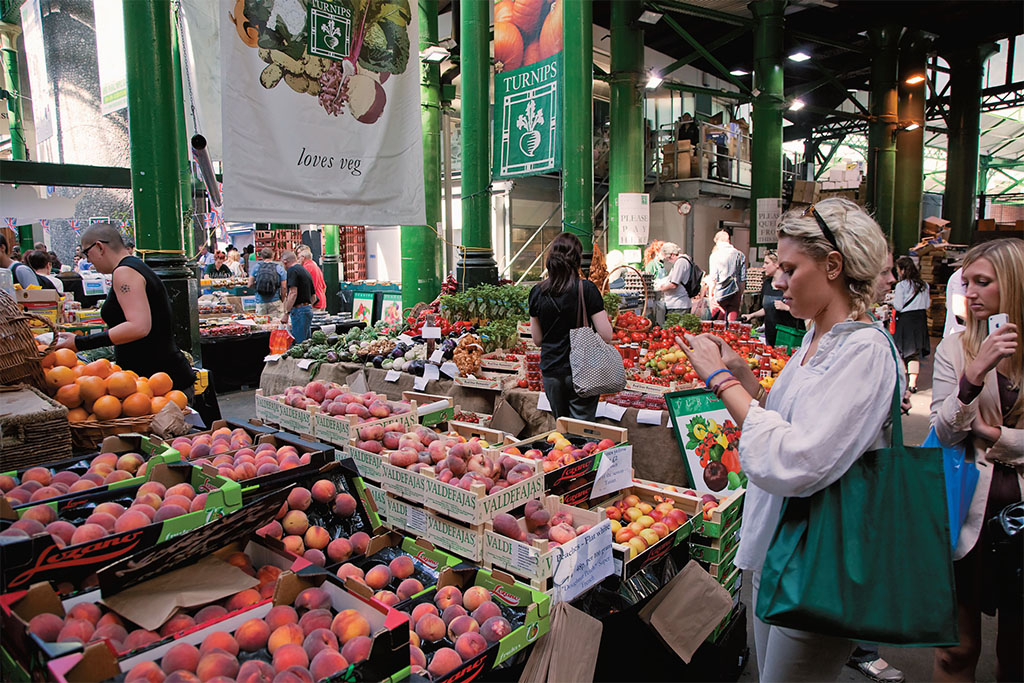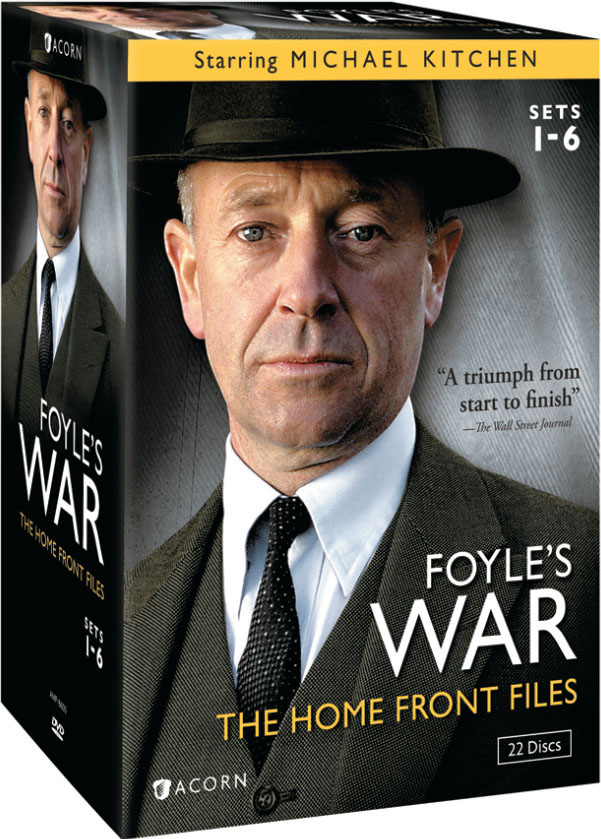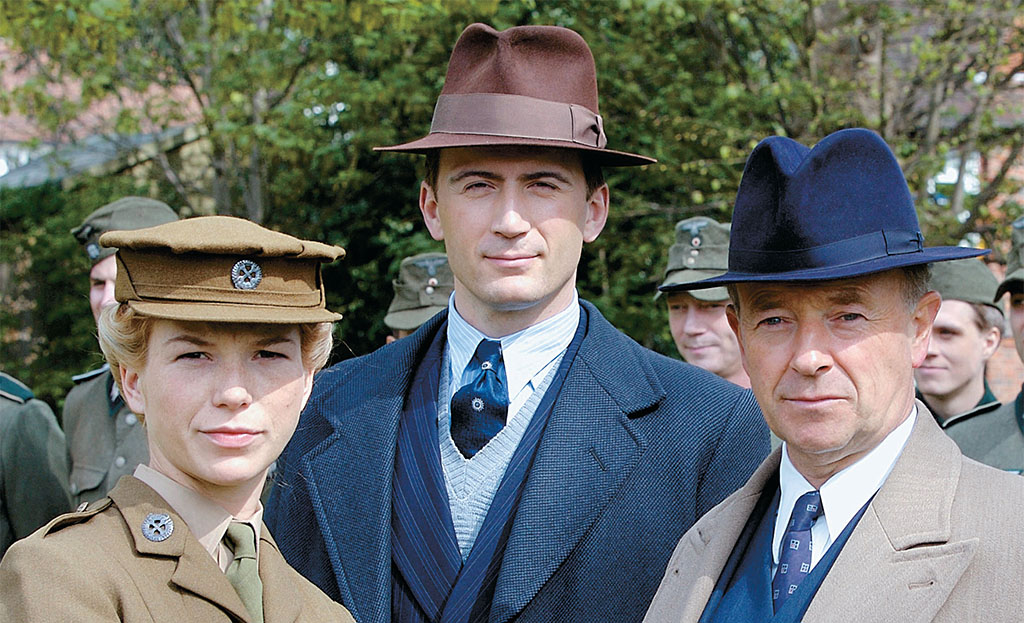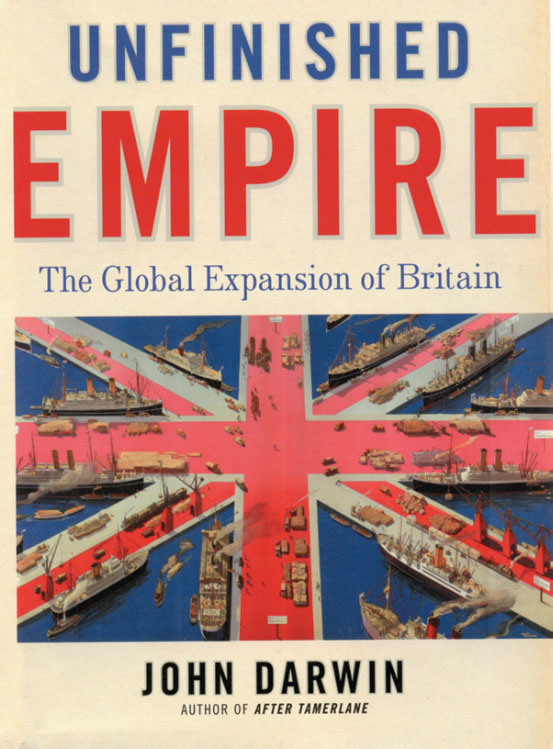
[caption id="ReinventingBoroughMarket_img1" align="aligncenter" width="1024"]

STEPHEN RAFFERTY/EYE UBIQUITOUS/PA IMAGES
AT THE SOUTH END OF LONDON Bridge, in the shadow of Southwark Cathedral, Borough Market has been reinvented for its entire existence. None of its 999 years, however, have changed the market like the past 10. Being kicked off the bridge itself in medieval times, closed by Parliament in the 18th century and having a railway line driven through it in the 20th hasn’t jaded it one bit, but serious money entering the area has changed the very nature of what the market sells.
When my dad was a child just after the war, it was still wholesale fruit and veg. He tells tales of sneaking across London Bridge in pre-dawn pea-souper fogs from Billingsgate (where his fishmonger father was buying supplies) to Borough for a change in costermonger banter. The language in both markets was pretty fruity, and the joshing between vendors famous, but for a small boy looking for drama, more damage and therefore more fun could be caused by flying cabbages between argumentative teenage vegetable porters.
There are still one or two wholesalers at Borough, but they have been relegated to the hinterlands. The market has become the go-to place for gourmands across London—and beyond—from smart people shopping for ingredients for that special dinner party to even smarter people doing their weekly shopping. Lunchtimes are especially busy with local office workers grabbing a snack, but by far the biggest group these days is the gastro-tourists, salivating at the sheer choice and quality of the fare.
And there is much to see in these labyrinthine passages, rendered even more maze-like by the new railway lines being cut through for the Crossrail project. Remembering that full markets are only on Thursdays, Fridays and Saturdays, expect to find cakes, pies, fruits, cheeses, sweetmeats, sauces and preserves under Victorian glass roofs and cast iron pillars topped by pineapples. Elaborately arranged displays of immaculate vegetables, fresh from the country or imported exotics. Bijou fish stalls, where the very best the new Billingsgate market (itself now relegated to Docklands) had to offer that morning nestled on beds of crushed ice and parsley. Game, from rabbit to pheasant, venison to hare, hanging from giant hooks on battered metal stands. Bread, hand-baked just a couple of hours ago, using stone-milled flours and specially fermented yeasts. Cheeses, either exclusively British like Neal’s Yard Dairy or one of the myriad Continental specialists. Chocolate, lovingly crafted from hand-ground beans and organic cream. The word “artisan” adorns pretty much every stall.
It’s all fabulous stuff, amongst the best in London, but like everything “best,” you’ll pay for it. I went to buy a whole pumpkin for a dinner party dish, admittedly a special pumpkin, but decided to cook something else when I discovered the squash alone would cost nearly £50.
Perhaps the best thing to do in Borough Market is just wander, taking in the atmosphere, perhaps buying a little cake for later or a jar of something to take home as a souvenir. When you’ve had enough of the buggy wheels, jostling crowds and food-bloggers’ cameras, there are seemingly infinite places to eat or drink, though you won’t find Harry Potter’s Leaky Cauldron, despite The Prisoner of Azkaban being filmed there.
Top end, you’re looking at one-name restaurants such as Roast or Fish, but there are dozens of cafes where you can get a coffee (the most famous is justly Monmouth Coffees; I like Patisserie Lila, whose cakes are divine) and traditional Victorian pubs such as the Market Porter and the gloriously curving Globe Tavern, now almost completely surrounded by high-level rail lines.
I often go to Beadles Wine Bar; the cellar is much less crowded than ground-level. But it is definitely worth wandering around the neighboring streets for less-crowded, just-as-interesting cafes, bars and historic pubs. If it all gets a little too much, you could always try the next big thing. Maltby Street Market in railway arches near Tower Bridge has a foodies-in-the-know buzz around it that Borough had 10 years ago, but hasn’t yet been discovered by the masses. It’s only a matter of time.
—Sandra Lawrence
DVD
Foyle’s War: The Home Front Files
22-disc set, Acorn Media, Silver Spring, Md., 22 episodes, approx. 37 hours, $149.99
AMONG THE MOST POPULAR British mystery series in recent years, Foyle’s War returns to PBS this September to kick off another season of Masterpiece Mystery. Michael Kitchen stars as DCS Christopher Foyle, who has spent his wartime service during World War II in charge of criminal investigation in the important channel port of Hastings, just across the strait from German-occupied France—on the front line of the Home Front of the war.
In wartime England, of course, the portfolio of a Detective Chief Superintendent expands to include espionage, profiteering, downed German pilots, smuggling, the black market and a multiplicity of motives and passions for murder and domestic crime. Though he longs to take a more active part in the war, DCS Foyle handles his lot and the case load with sang froid, wry humor and subtle warmth, never surprised nor seemingly changed by the array of human wickedness and failure that continually parades before him.
[caption id="ReinventingBoroughMarket_img2" align="aligncenter" width="1024"]

COURTESY OF ACORN MEDIA
Foyle’s is a small, but hugely sympathetic, entourage. His sergeant, Paul Milner (Anthony Howell), was a policeman before joining up at the outbreak of war. After he lost a leg in the disastrous expedition in Norway, Foyle brought Milner back to serve as his aide-de-camp. Never having learned to drive, Foyle has a police driver, Sam Stewart (Honeysuckle Weeks), an optimistic barely-20s-something daughter of a vicar, with a ready smile and an eagerness to be of help. It is impossible not to like them all.
[caption id="ReinventingBoroughMarket_img3" align="aligncenter" width="601"]

With the upcoming unveiling of this new series, Acorn Media has released a complete collection of 22 episodes comprising the first six series of Foyle’s War since its inception on PBS in 2003. Each of these full-length dramas can be thoroughly enjoyed as a stand-alone story. Together, however, the series unfolds England’s war years chronologically from the early months and the Dunkirk evacuation through to VE-Day and now, in the latest series, to the difficult aftermath and the war’s continued privations and effects.
Foyle is not Miss Marple, lost in a timeless English village. The viewer shares Foyle’s experience against the very real(and scrupulously accurate) backdrop of Britain’s six years of war. As classic British murder mysteries, Foyle’s War stories rate right up there with the best of them. Together, as a unified narrative of the Home Front war on the English Channel coast, the series is brilliant, and rather incomparable.
BOOK
Unfinished Empire: The Global Expansion of Britain
by John Darwin,
Bloomsbury Publishing, New York, 480 pages, hardcover, &doller;35.
FOR 200 YEARS BRITAIN had an empire that circled the globe. For a century “the sun never set” on the island’s global dominions. When we think of the British Empire, we conjure an image of administrative efficiency, military might that included the largest, most powerful navy in the world, moral self-confidence and a stiff upper lip.
As John Darwin brilliantly exposes in Unfinished Empire, the global economic and political juggernaut that Great Britain became, however, was largely accomplished with smoke and mirrors. In fact, Britain bluffed and swaggered its way to empire with little forethought and no “master plan.” Unpacked bit by bit, the British Empire was a strange kaleidoscope of motives, aims, political pragmatism and economic migration.
A Notice from the Editor
Dear Subscriber,
Some of you have recently reported suspicious phone calls or offers in the mail to renew your subscription to British Heritage magazine. Your uneasiness may be justified. While still rare, fraudulent mailings and phone calls are increasing. We have confirmed that criminal organizations are attempting to represent themselves as the Weider History Group, asking for a check or credit card number to renew your subscription. They take your money but cannot deliver the subscription.
These simple guidelines can help you avoid becoming a victim:
▪ Before renewing, check your mailing label. You’ll find your expiration date on the line above your name, the second item from right. If your subscription has not expired and you receive a phone call asking for your renewal, it is fraudulent. The Weider History Group will not telephone you to renew unless your subscription has actually expired.
[caption id="ReinventingBoroughMarket_img4" align="aligncenter" width="176"]

▪ Look carefully at mail requests. We do not begin mailing renewal efforts more than about six months before your subscription expires. We will never ask you to write a check to anyone other than British Heritage magazine or the Weider History Group, and our mailing address on the return envelope should be Palm Coast, FL 32142, with P.O. Box 420579, 420580 or 420581.
▪ If you are uncertain about any offer you receive, simply phone us toll free at 1-800-435-0715. Orders placed through this number are secure. Or you can go online and place your order at www.HistoryNet.com and click on the secure link for “Subscription Help.”
We sincerely appreciate having you as a faithful reader and we are eager to help make the experience of subscribing to British Heritage magazine pleasurable. Always feel free to contact the editor, Dana Huntley, at [email protected].
[caption id="ReinventingBoroughMarket_img5" align="aligncenter" width="553"]

To think of the Empire as a unified whole becomes itself suspect in Darwin’s unfolding of the story. Certainly the “settler colonies” of New Zealand, Australia, Canada and South Africa had a far different relationship with the Mother Country than did such far flung appendages as the Caribbean islands, sub-Saharan Africa, the Indian subcontinent and a raft of islands scattered from the Falklands to the South Pacific. In each case, however, British colonial policy was shaped piecemeal as particular circumstances dictated in each case. Far from having any unified plan or goal in the building of a colonial empire, Britain made it up as they went along.
Unfinished Empire is a superb, fresh analysis of the ideas and forces that created Britain’s colonial enterprise. The book is eminently readable with a clear narrative focus and a livelier prose than most proper histories can claim. This is a major contribution to colonial history, and a fascinating read.





Comments